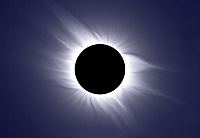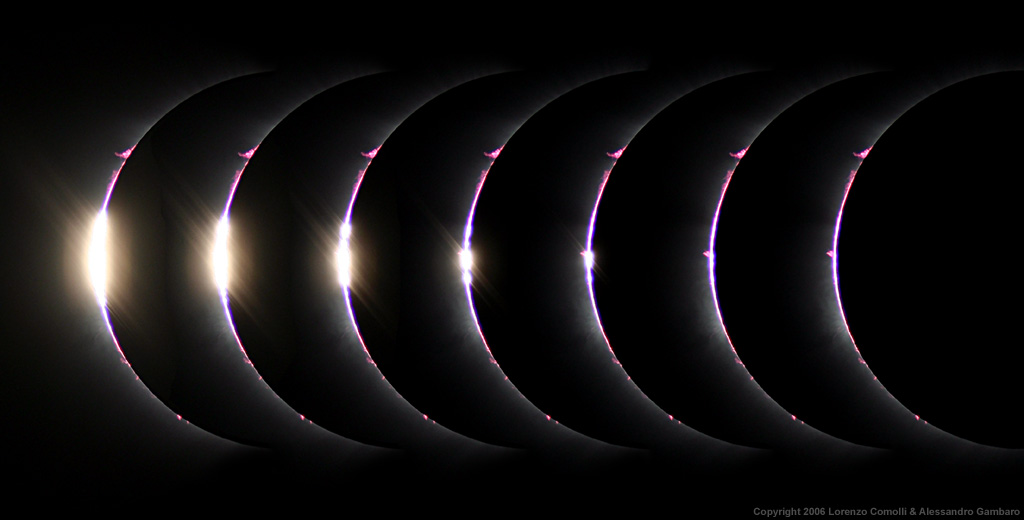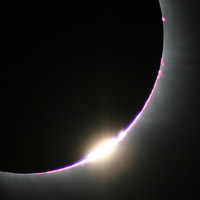
The images of the Total Solar
Eclipse of 29 March 2006,
by Lorenzo Comolli and
Alessandro
Gambaro

 |
The images of the Total Solar
Eclipse of 29 March 2006, |
 |
 |
| Canon EOS
350D Hutech digital camera, set at 100 ISO, RAW format, Pentax 75 apochromatic refractor, 75mm f/6.7
average of 10 images from 1/500s
to
1s, without filters. Elaboration
in Photoshop and Iris to enhance the coronal details. Addition of the
prominences from T2 and T3 images and the Moon ashen light. |
 |
| The sequence is an image that
show in a quick glance all the evolution of the phenomena. This image
is achieved on Fuji Provia 100F film, using a 50mm objective. 29
exposures from 9.30 to 11.50 UT at regular intervals of 5 min,
astrosolar filter plus yellow filter for partial phases, 1/60s exposure
at f/5.6, no filters in totality and exposure of 2s at f/5.6. The
result is achieved automatically with an artigianal intervallometer
made by our friend Giorgio Bussini that we'd like to thank! So we where
free to focus on other topics, the only obligation was to remove the
filters and change the exposure time immediately before the totality,
and to revert immediately after. |
 |
| A 360° panorama of the
horizon give an idea of the impressing all-direction sunset. Venus is
visible at SW, while our instruments are between NE and E. Composed
using 8 frames with a Vivitar 19mm objective, closed at f/5.6 and Fuji
Sensia 100 ISO film, 1/2s exposure time. Approximative hour of the
mosaic: from 10.38 to 10.39 UT, so in the first minute of totality. |
 |
| Thanks to Eclipse software of
Fred Bruenjes, our totality was free from the obligation of taking the
main instrument photos, and we have a lot of time to reserve for
ambient images, binocular observations and panorama observation. In
this image one of the authors (Lorenzo) is near the telescope, between
the binoculars. Unfortunately after this image the mechanical camera
jammed, without any reason, never happened! So we were not able to take
more images with Alessandro near the telescopes. Please note the PC in
the lower-left corner with Eclipse software that is taking all the
images. At the top the totality. Imaged with a Vivitar 19mm f/5.6
objective, Fuji Sensia 100 ISO film, 1/2s exposure time. Exact time of
the image is -47s from MAX, as can be read from a hires version of
thisimage from the monitor of the PC. |
 |
| This special elaboration show 23
stars in the sky around the Sun, but to see them we strongly suggest to
view the high resolution version. The
background image with the stars is a 1s exposure, while the corona was
added above the saturated part of the exposure. Canon EOS 350D digital reflex, Hutech modified, set at 100 ISO, RAW format, Pentax 75 apo refractor (dia 75mm f/6.7). |
 |
| Here are all the phases of the
second contact, thanks to our camera that was shooting continuosly. The
same images was also used to make the animation presented below.
Elaboration made by our friend Emmanuele Sordini, thanks! Pentax75 apo refractor and Canon 350D, 1/1000s exp, shooting about one frame every second in JPG large format, 100 ISO (T2 at 10.38.06 UT). |
 |
This video show the central minutes of the eclipse, with the T2 and T3 contacts and the corona. The audio track reveal the atmophere that we were living... After the totality the joy exploded because we were able to observe the eclipse and to take the main photos. Unfortunately the secondary camera, a Canon 300D with a 200mm objective don't taka any frame, even if during all pre-eclipse the tests all worked perfectly. Click
on the image at left to download the video of 7 minutes, DivX 5.21 format,
with mp3 audio track. Dimension: 12MB.
Also in
Flash SWF
format.
If you cannot download
such a big files, listen to the audio
track in mp3 format (1MB). |

|
Animation of the second contact, using the images of
Pentax75 and Canon 350D, 1/1000s exposure time, obtained at about 1fps
in JPG large format, 100 ISO, from T2-25s to T2+15s, (T2 at 10.38.06
UT). The animation is avaiable at accelerated speed of 5fps without
audio or at 1fps with audio. Click on the image at left to download the animation, in DivX 5.21 format. Also in Flash SWF format. |
 |
Animation of the third contact,
using the images of Pentax75 and Canon 350D, 1/1000s exposure time,
obtained at about 1fps in JPG large format, 100 ISO, from T3-15s to
T3+25s,
(T3 at 10.42.02 UT). The animation is avaiable at accelerated speed of
5fps without audio or at 1fps with audio. Click on the image at left to download the animation, in DivX 5.21 format. Also in Flash SWF format. |
 |
Animation of the complete eclipse, using the images of Pentax75 and Canon 350D,
1/125s exposure time in partial phases with a glass solar filter D5,
and from 1/2000s to 1s in totality. Click on the image at left to download the animation, in DivX 6 format. Also in Flash SWF format. |
 |
...of the desert camp |
| ...of the travel |
 |
We'd
like to thank a lot Fred for his wonderful software "Eclipse" that
automatically took 327 images during totality, with exposure times from
1/4000 to 4s, in JPG large and RAW format. We used the 0.3.2 beta
version (of March 17, 2006) and we developed a custom script. For more informations visit Fred's software page and Fred's eclipse images. |
|
|
 |